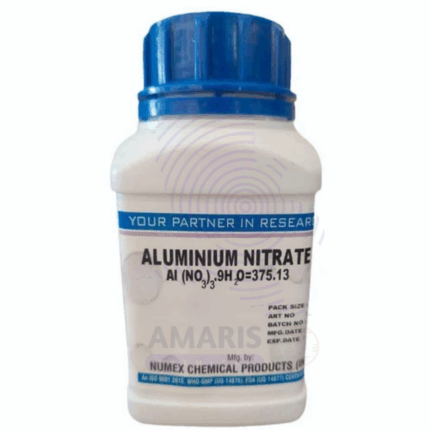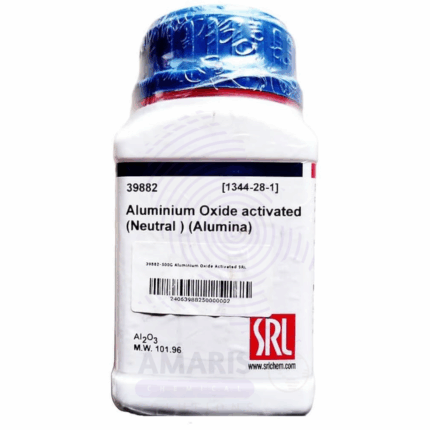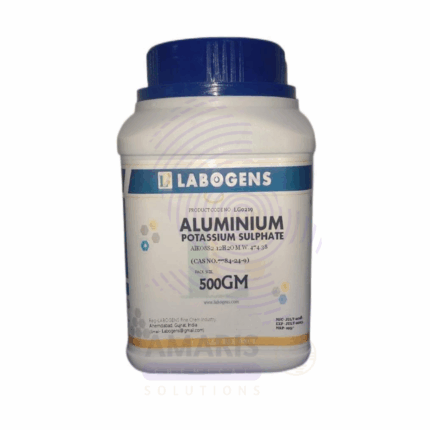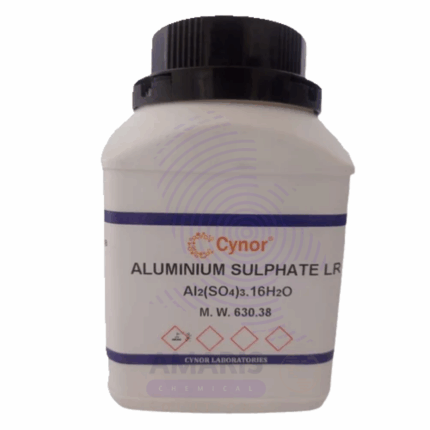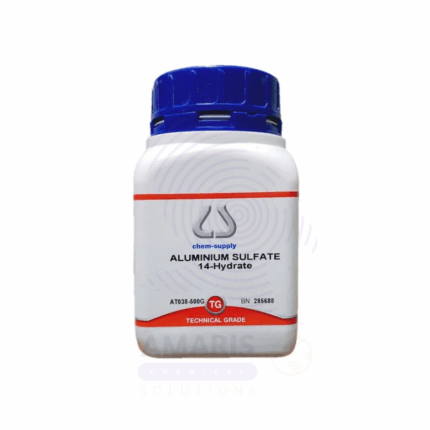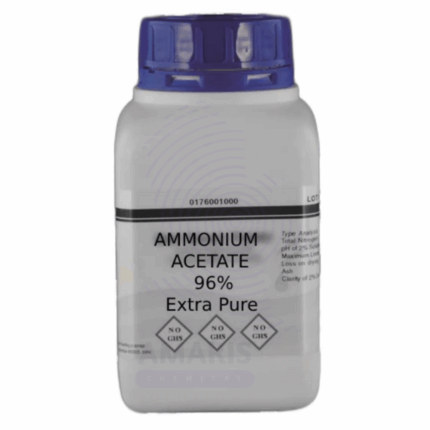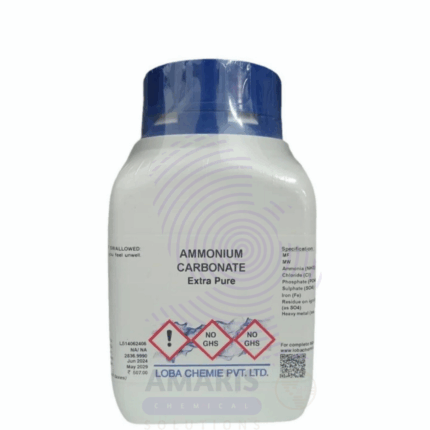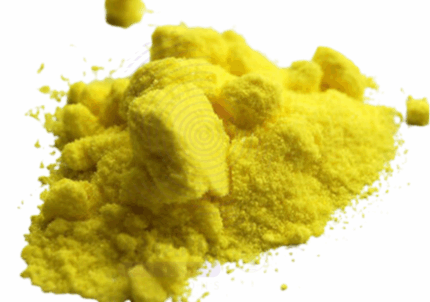
Diastase Enzyme Powder Extra Pure
$ 17.10
Diastase Enzyme Powder Extra Pure is a high-activity amylolytic enzyme preparation used in laboratory settings to catalyze the breakdown of starch into simpler sugars like maltose and glucose. It plays a crucial role in biochemical and enzymatic assays, fermentation studies, and educational demonstrations involving carbohydrate metabolism. This extra pure grade ensures high enzyme purity, offering reliable and reproducible results in analytical work and research. Ideal for controlled hydrolysis experiments and studies on enzyme kinetics, it should be stored in a cool, dry place to preserve its enzymatic activity and stability.
Diastase Enzyme Powder Extra Pure
Primary Uses
- Starch Hydrolysis Experiments
- Diastase catalyzes the breakdown of starch into maltose and glucose, ideal for teaching enzyme kinetics and carbohydrate metabolism.
- Biochemical Studies
- Used in assays to study amylolytic activity, enzyme specificity, and optimal conditions (pH, temperature) for enzymatic action.
- Pharmaceutical Testing
- Included in digestive enzyme formulations and evaluated for enzyme activity levels under various storage and formulation conditions.
Secondary Uses
- Food Chemistry Labs – Demonstrates enzymatic conversion of starches in beer brewing, baking, and fermentation science.
- Histochemistry – Occasionally used in tissue digestion protocols before staining procedures.
- Comparative Enzyme Studies – Paired with amylase, papain, or cellulase for multi-enzyme reaction demonstrations.
| PACK SIZE |
100 grams Plastic Tin |
|---|
1. Basic Identification Attributes
- Chemical Name: Diastase
- Other Name(s): Amylase (Mixture of α- and β-amylase enzymes)
- CAS Number: 9000-92-4
- Grade: Extra Pure (Laboratory Grade)
- Appearance: Off-white to light beige powder
- Source: Typically derived from malted grain or microbial fermentation
2. Physical & Chemical Properties
- Solubility: Soluble in water; insoluble in alcohol
- Enzymatic Activity: Hydrolyzes starch into maltose and dextrins
- pH Range of Activity: Optimal at pH 4.6–6.0
- Temperature Stability: Active at 30 °C to 70 °C (denatures above ~80 °C)
- Odor: Slight fermentation-like or neutral
3. Safety & Hazard Attributes
- GHS Classification: May cause respiratory sensitization (Category 1)
- Hazard Statements:
- H334: May cause allergy or asthma symptoms or breathing difficulties if inhaled
- Precautionary Measures:
- Avoid inhalation of enzyme dust
- Use appropriate PPE: gloves, goggles, dust mask or respirator
- Avoid contact with mucous membranes
- First Aid:
- Inhalation: Move to fresh air; seek medical help if symptoms persist
- Skin Contact: Wash with soap and water
- Eye Contact: Rinse thoroughly with water
- Ingestion: Rinse mouth; seek medical attention if large quantities are consumed
4. Storage & Handling Attributes
- Storage Conditions:
- Store in a cool, dry, tightly sealed container
- Protect from heat, light, and moisture
- Shelf Life: Typically 1–2 years when stored properly
- Handling Advice:
- Avoid creating airborne dust
- Use in a well-ventilated area or fume hood for bulk handling
5. Regulatory & Compliance Attributes
- EC Number: 232-565-6
- REACH Status: Exempt (naturally derived enzyme)
- Transport Classification: Not regulated as hazardous
6. Laboratory Applications
- Primary Uses:
- Starch hydrolysis experiments in biology and biochemistry
- Enzymatic digestion in food and fermentation analysis
- Quality control testing in brewing and distilling
- Demonstrations in enzymology and kinetics labs
- Other Uses:
- Brewing industry (mashing process)
- Diagnostic reagent in biolabs
- Educational enzyme activity experiments
SAFETY PRECAUTIONS
- PPE Required:
- Dust mask or respirator (enzyme powders can be allergenic)
- Gloves
- Lab coat
- Safety goggles
- Storage Guidelines:
- Store in a cool, dry place (preferably 2–8°C in sealed container)
- Protect from moisture, heat, and direct sunlight
- Avoid repeated freeze-thaw cycles if stored in solution
- Handling Tips:
- Avoid inhalation of fine powder – work in a well-ventilated area or fume hood
- Clean spills promptly to prevent airborne enzyme particles
- Prevent contamination by using clean spatulas and containers
FIRST AID MEASURES
- Inhalation: Move to fresh air; seek medical help if respiratory symptoms develop
- Skin Contact: Wash thoroughly with soap and water
- Eye Contact: Flush eyes with water for at least 15 minutes; seek medical advice
- Ingestion (Lab Use): Rinse mouth, do not induce vomiting; seek medical attention
FIRE SAFETY MEASURES
- Fire Hazard: Not flammable under normal conditions
- Explosion Risk: Fine dust may form combustible mixtures with air
- Extinguishing Agents: Water spray, CO₂, dry chemical
- Combustion Products: May produce carbon oxides (CO, CO₂)
Related products
Aluminium Nitrate Extra Pure
Aluminium Oxide Active Neutral Extra Pure
Aluminium Potassium Sulphate Hydrated Extra Pure
Aluminium Sulphate Anhydrous Extra Pure
Aluminium Sulphate Hydrous Extra Pure
Ammonium Acetate Extra Pure
Ammonium Carbonate Extra Pure
Ammonium Carbonate Extra Pure is a high-quality, white crystalline solid widely used across various scientific, industrial, and food-related applications. Manufactured to stringent purity standards, this compound is ideal for laboratories and processes that demand high-grade reagents. With its characteristic ammonia-like odor and ability to decompose upon heating, ammonium carbonate plays a versatile role in both chemical reactions and physical processes.
In aqueous solution, ammonium carbonate breaks down into ammonium bicarbonate and ammonium carbamate, further releasing ammonia (NH₃) and carbon dioxide (CO₂) upon heating. This property makes it especially useful in applications that require controlled gas release or temporary pH modification.


 Preservatives(food)
Preservatives(food) Flavor Enhancers
Flavor Enhancers Acidulants
Acidulants Sweeteners
Sweeteners Antioxidants
Antioxidants Colorants(food)
Colorants(food) Nutraceutical Ingredients (food)
Nutraceutical Ingredients (food) Nutrient Supplements
Nutrient Supplements Emulsifiers
Emulsifiers
 Collectors
Collectors Dust Suppressants
Dust Suppressants Explosives and Blasting Agents
Explosives and Blasting Agents Flocculants and Coagulants
Flocculants and Coagulants Frothers
Frothers Leaching Agents
Leaching Agents pH Modifiers
pH Modifiers Precious Metal Extraction Agents
Precious Metal Extraction Agents
 Antioxidants(plastic)
Antioxidants(plastic) Colorants (Pigments, Dyes)
Colorants (Pigments, Dyes) Fillers and Reinforcements
Fillers and Reinforcements Flame Retardants
Flame Retardants Monomers
Monomers Plasticizers
Plasticizers Polymerization Initiators
Polymerization Initiators Stabilizers (UV, Heat)
Stabilizers (UV, Heat)
 Antifoaming Agents
Antifoaming Agents Chelating Agents
Chelating Agents Coagulants and Flocculants
Coagulants and Flocculants Corrosion Inhibitors
Corrosion Inhibitors Disinfectants and Biocides
Disinfectants and Biocides Oxidizing Agents
Oxidizing Agents pH Adjusters
pH Adjusters Scale Inhibitors( water)
Scale Inhibitors( water)
 Antioxidants(cosmetic)
Antioxidants(cosmetic) Emollients
Emollients Fragrances and Essential Oils
Fragrances and Essential Oils Humectants
Humectants Preservatives
Preservatives Surfactants(cosmetic)
Surfactants(cosmetic) Thickeners
Thickeners UV Filters
UV Filters
 Fertilizers
Fertilizers Soil Conditioners
Soil Conditioners Plant Growth Regulators
Plant Growth Regulators Animal Feed Additives
Animal Feed Additives Biostimulants
Biostimulants Pesticides (Herbicides, Insecticides, Fungicides)
Pesticides (Herbicides, Insecticides, Fungicides)
 Active Pharmaceutical Ingredients (APIs)
Active Pharmaceutical Ingredients (APIs) Excipients
Excipients Solvents(pharmaceutical)
Solvents(pharmaceutical) Antibiotics
Antibiotics Antiseptics and Disinfectants
Antiseptics and Disinfectants Vaccine Adjuvants
Vaccine Adjuvants Nutraceutical Ingredients (pharmaceutical)
Nutraceutical Ingredients (pharmaceutical) Analgesics & Antipyretics
Analgesics & Antipyretics
 Analytical Reagents
Analytical Reagents Solvents(lab)
Solvents(lab) Chromatography Chemicals
Chromatography Chemicals Spectroscopy Reagents
Spectroscopy Reagents microbiology-and-cell-culture-reagents
microbiology-and-cell-culture-reagents Molecular Biology Reagents
Molecular Biology Reagents Biochemical Reagents
Biochemical Reagents Inorganic and Organic Standards
Inorganic and Organic Standards Laboratory Safety Chemicals
Laboratory Safety Chemicals Specialty Laboratory Chemicals(Special Laboratory Equipment)
Specialty Laboratory Chemicals(Special Laboratory Equipment)
 Demulsifiers
Demulsifiers Hydraulic Fracturing Fluids
Hydraulic Fracturing Fluids Scale Inhibitors(oil)
Scale Inhibitors(oil) Surfactants(oil)
Surfactants(oil) Drilling Fluids
Drilling Fluids
 Dyes and Pigments
Dyes and Pigments Bleaching Agents
Bleaching Agents Softening Agents
Softening Agents Finishing Agents
Finishing Agents Antistatic Agents
Antistatic Agents
 Admixtures
Admixtures Waterproofing Agents
Waterproofing Agents Sealants and Adhesives
Sealants and Adhesives Curing Compounds
Curing Compounds Concrete Repair Chemicals
Concrete Repair Chemicals Anti-Corrosion Coatings
Anti-Corrosion Coatings
 Surfactants(cleaning)
Surfactants(cleaning) Builders
Builders Enzymes
Enzymes Solvents (Cleaning)
Solvents (Cleaning) Fragrances
Fragrances
 Electronic Chemicals
Electronic Chemicals Catalysts
Catalysts Lubricants
Lubricants Photographic Chemicals
Photographic Chemicals Refrigerants
Refrigerants Automotive chemicals
Automotive chemicals Pyrotechnic Chemicals
Pyrotechnic Chemicals
 Biodegradable Surfactants
Biodegradable Surfactants Bio-based Solvents
Bio-based Solvents Renewable Polymers
Renewable Polymers Carbon Capture Chemicals
Carbon Capture Chemicals Wastewater Treatment Chemicals
Wastewater Treatment Chemicals
 Pigments
Pigments Solvents(paint)
Solvents(paint) Specialty Coatings
Specialty Coatings Binders/Resins
Binders/Resins Additives
Additives Driers
Driers Anti-Corrosion Agents
Anti-Corrosion Agents Functional Coatings
Functional Coatings Application-Specific Coatings
Application-Specific Coatings
 Fresh Herbs
Fresh Herbs Ground Spices
Ground Spices Whole Spices
Whole Spices Spice Blends
Spice Blends Dried Herbs
Dried Herbs
 Leavening Agents
Leavening Agents Dough Conditioners
Dough Conditioners Flour Treatments
Flour Treatments Fat Replacers
Fat Replacers Decoratives
Decoratives Preservatives(baking)
Preservatives(baking)
 Plasticizers & Softeners
Plasticizers & Softeners Reinforcing Agents
Reinforcing Agents Adhesion Promoters
Adhesion Promoters Vulcanizing Agents
Vulcanizing Agents Antidegradants
Antidegradants Blowing Agents
Blowing Agents Fillers & Extenders
Fillers & Extenders Accelerators & Retarders
Accelerators & Retarders


